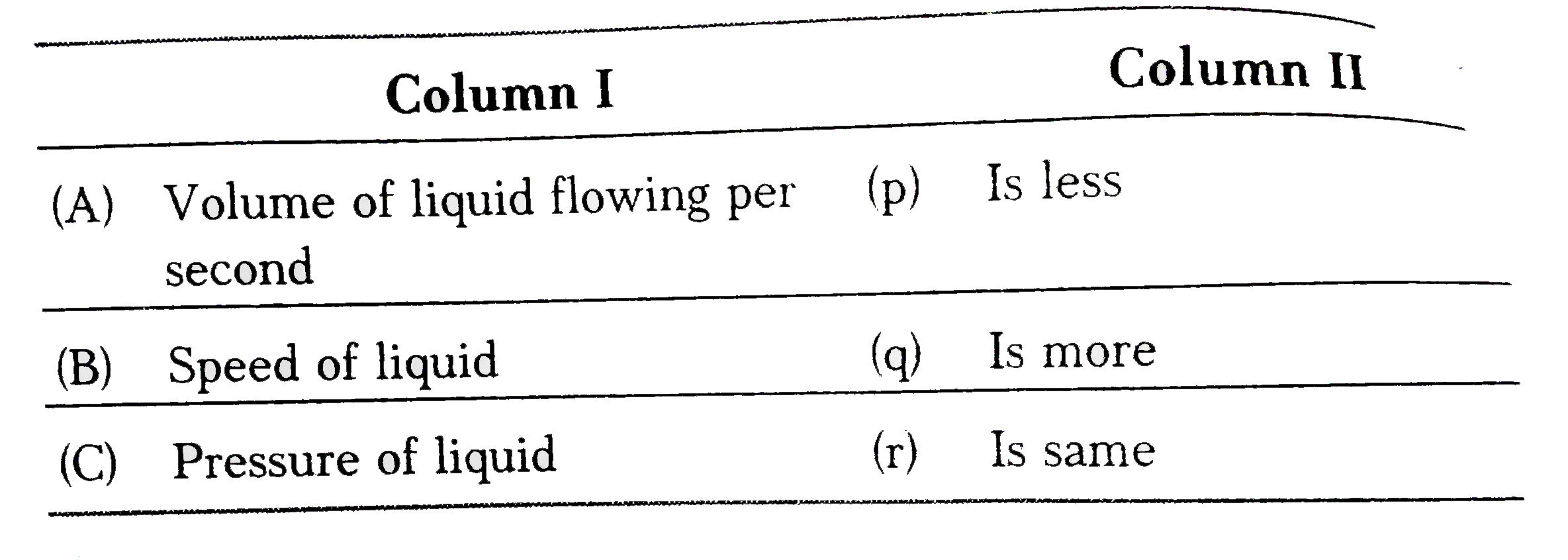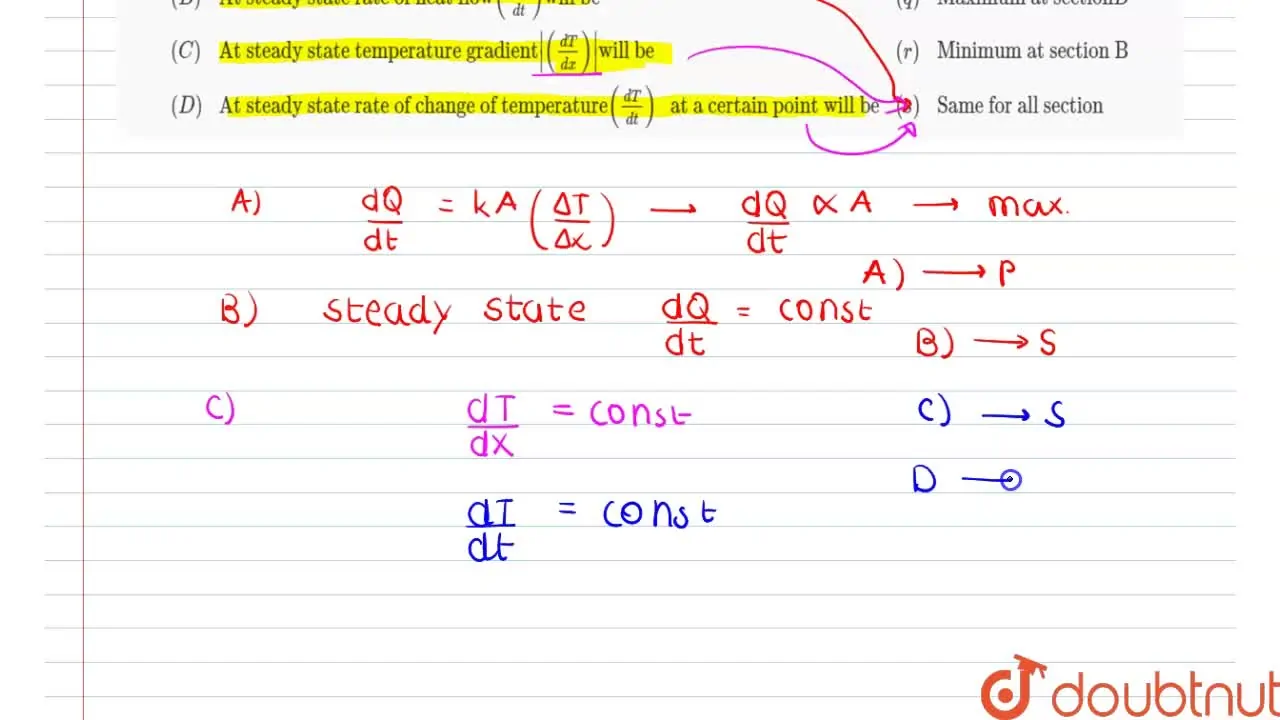A copper rod (initially at room temperature 20∘C) of non-uniform cross section is placed between a steam chamber at 100∘C and ice-water chamber at 0∘C. A and B are cross sections are as shown in figure. Then match the statements in column -I with results in columns-II using comparing only between cross section A and B. (The mathematical expressions in column-I have usual meaning in heat transfer).
_E01_154_Q01.png)
Column-IColumn-II(A)initially rate of heat flow(dQdt)will be (p)Maximum at sectionA(B)At steady state rate of heat flow(dQdt)will be (q)Maximum at sectionB(C)At steady state temperature gradient∣∣(dTdx)∣∣will be (r)Minimum at section B(D)At steady state rate of change of temperature(dTdt) at a certain point will be(s)Same for all sectionSolution in Gujrati
Initially rate of heat flow will be maximum at A and minimum at B as there is no temperature difference across section B.
In steady state dQdt will be same.
In steady state dQdt=−KAdTdx= same & dTdt=0⇒(dTdx)∝1A⇒(dTdx)
will be maximum at B & minimum at A
Related Playlists
- BOOK - ALLEN CHAPTER - GEOMETRICAL OPTICSEXERCISE - ASSERTION-REASON40videos
GEOMETRICAL OPTICS
- BOOK - ALLEN CHAPTER - GEOMETRICAL OPTICSEXERCISE - Comprehension Based Questions66videos
GEOMETRICAL OPTICS
- BOOK - ALLEN CHAPTER - GEOMETRICAL OPTICSEXERCISE - EXERCISE -0282videos
GEOMETRICAL OPTICS
- BOOK - ALLEN CHAPTER - CURRENT ELECTRICITYEXERCISE - EX.II66videos
CURRENT ELECTRICITY
- BOOK - ALLEN CHAPTER - GRAVITATIONEXERCISE - EXERCISE 49videos
GRAVITATION
Similar Questions
Statement-1: A real gas behaves as an ideal gas at high temperature and low pressure .
Statement-2: Liquid state of an ideal gas is impossible.03:07View SolutionA certain amount of ice is supplied heat at a constant rate for 7 min. For the first one minute the temperature rises uniformly with time. Then it remains constant for the next 4 min and again the temperature rises at uniform rate for the last 2 min. Given Sice=0.5cal/g∘C,Lf=80cal/g.
The initial temperature of ice isView SolutionA triangular plate has two cavities , one square and one rectangular as shown in figure . The plate is heated.
_E01_066_Q01.png) 02:53View Solution
02:53View SolutionIn the Bohr's model of hy drogen atom, the electron moves around the nucleus in a circular orbit of radius 5×10−11m. Its time period is 1.5×10−16s. The current associated with the electron motion is:-
04:00View SolutionAssertion : The difference in the value of acceleration due to gravity at pole and equator is proportional to square of angular velocity of earth.
Reason : the value of acceleration due to gravity is minimum at the equator and maximum at the pole.04:15View SolutionTwo rods (one semi-circular and other straight) of same material and of same cross-sectional area are joined as shown in the figure. The point A and B are maintained at different temperature. Find the ratio of the heat transferred through a cross-section of a semi-circular rod to the heat transferred through a cross section of the straight rod in a given time.
 01:47View Solution
01:47View SolutionA conducting cylindrical rod of uniform cross-sectional area is kept between two large chambers which are at temperatures 100∘C and 0∘C, respectively. The cconductivety of the rod increases with x, where x is distance from 100∘C end. The temperature profile of the rod in steady -state will be as
 04:29View Solution
04:29View SolutionCurrent is flowing through a wire of non-uniform cross section. Cross section of wire at A is les than the cross section of wire at B. Then match the following
 03:06View Solution
03:06View SolutionA liquid is flowing through a pipe of non-uniform cross-section. At a point where area of cross-section of the pipe is less, match the following columns.
 03:31View Solution
03:31View SolutionA copper rod (initially at room temperature 20∘C) of non-uniform cross section is placed between a steam chamber at 100∘C and ice-water chamber at 0∘C. A and B are cross sections are as shown in figure. Then match the statements in column -I with results in columns-II using comparing only between cross section A and B. (The mathematical expressions in column-I have usual meaning in heat transfer).
_E01_154_Q01.png)
Column-IColumn-II(A)initially rate of heat flow(dQdt)will be (p)Maximum at sectionA(B)At steady state rate of heat flow(dQdt)will be (q)Maximum at sectionB(C)At steady state temperature gradient∣∣(dTdx)∣∣will be (r)Minimum at section B(D)At steady state rate of change of temperature(dTdt) at a certain point will be(s)Same for all section03:58View SolutionA conical section of a pipe is shown in figure through which water is flowing. Let A be the area of crosss-section, r be the radius of cross-section, P be the pressure at a point difference and v be the velocity of water.

Match the column-I with column-II containing values of ratio of quantities given in Column-I
 01:46View Solution
01:46View SolutionEach question in this section contains statements given in two columns which have to be matched. Statements in Column I are labetted as A,B, C, and D where as statements in Column II are labelled (p), (q), (r) and (s).

 03:08View Solution
03:08View SolutionColumn-I gives physical quantities based on a situation in which an ideal cell of e.m.f. V is connected across a cylindrical rod of uniform cross-section area and conductivity ( sigma ) as shown in figure. E, J, phi and i are electric field, current density, electric flux and current through shaded cross-section respectively as shown in figure. Physical quantities in Column-II are equal to those in column I. Match the expression in Column-I with the statements in Column-II.
04:23View SolutionCurrent is flowing through a wire of non-uniform cross section. Cross section of wire at A is les than the cross section of wire at B. Then match the following
05:49View SolutionA liquid is flowing through a pipe of non-uniform cross-section. At a point where area of cross-section of the pipe is less, match the following columns.
10:59View SolutionWill the height of the water column change if the cross section of the water column is made wider ?
02:48View Solution


